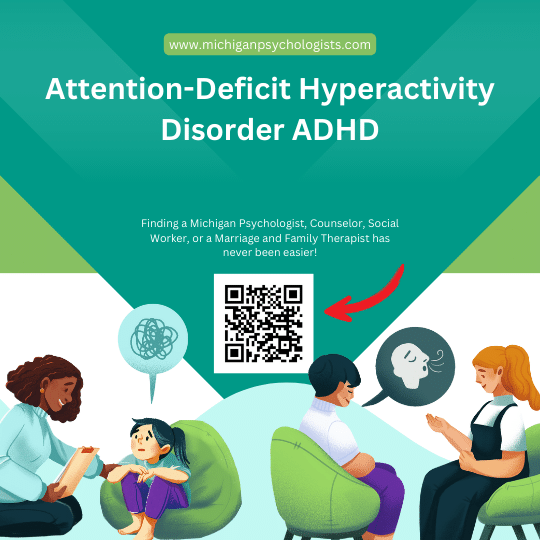Attention-Deficit Hyperactivity Disorder ADHD
Home » Guide to DSM-5-TR Mental Health Disorders and Diagnostic Categories » Attention-Deficit Hyperactivity Disorder ADHD

Table of Contents
Diagnostic Criteria For Attention-Deficit/Hyperactivity Disorder (ADHD)
Inattention
ADHD is characterized by a persistent pattern of inattention and/or hyperactivity-impulsivity that interferes with functioning or development. Symptoms of inattention include failing to give close attention to details, difficulty sustaining attention, not seeming to listen when spoken to directly, not following through on instructions, difficulty organizing tasks and activities, avoiding tasks that require sustained mental effort, losing things necessary for tasks, being easily distracted, and being forgetful in daily activities. These symptoms must have been present for at least six months to a degree that is inconsistent with developmental level and negatively impacts social and academic/occupational activities.
Hyperactivity and Impulsivity
Symptoms of hyperactivity and impulsivity include fidgeting, leaving seat in situations when remaining seated is expected, running or climbing in inappropriate situations, being unable to play or engage in activities quietly, being “on the go” as if “driven by a motor,” talking excessively, blurting out answers, difficulty waiting for their turn, and interrupting or intruding on others. These symptoms must also have been present for at least six months and cause significant impairment in social, academic, or occupational functioning.
Presentation of ADHD
Children
In children, ADHD often presents with noticeable hyperactivity and impulsivity. They may have trouble sitting still, following directions, and waiting their turn. They often interrupt others, blurt out answers, and have difficulty playing quietly. Inattention symptoms might include a tendency to daydream, being easily distracted, and struggling to complete schoolwork or chores. These behaviors can lead to academic underachievement, difficulty in social interactions, and strained family relationships.
Teens
In adolescents, hyperactivity may decrease, but symptoms of inattention and impulsivity often persist. Teens with ADHD may struggle with time management, organization, and setting priorities. They might have difficulty maintaining focus during lectures, completing homework on time, and sustaining effort on tasks that require prolonged attention. Socially, they may experience peer rejection and have higher rates of risky behaviors, such as substance abuse and unsafe driving practices.
Adults
In adults, ADHD can manifest as chronic disorganization, poor time management, and difficulties in sustaining attention in work and social settings. Adults might experience restlessness, an inability to relax, and challenges in maintaining relationships. They often have a history of academic underachievement, job difficulties, and a higher likelihood of co-occurring mental health conditions, such as anxiety and depression. Symptoms of impulsivity in adults can include hasty decision-making and trouble with self-regulation.
Males
ADHD is more frequently diagnosed in males than females. Males often exhibit more externalizing symptoms, such as hyperactivity and impulsivity, which are more noticeable and thus more likely to lead to diagnosis. Boys with ADHD may be seen as disruptive in school settings, leading to earlier and more frequent referrals for assessment.
Females
Females with ADHD are often underdiagnosed and misdiagnosed. They are more likely to exhibit inattention rather than hyperactivity, which can be overlooked in classroom settings. Girls with ADHD may be seen as daydreamers or shy, leading to a lack of recognition of their condition. They are at greater risk for internalizing symptoms, such as anxiety and depression, due to the social difficulties and academic challenges associated with their inattention.
Treatment Options for ADHD
Children
Treatment for children with ADHD often includes behavioral interventions, parent training, and educational support. Behavioral interventions might focus on teaching children how to manage their symptoms and develop coping strategies. Parent training programs can help parents learn how to support their child’s development and manage challenging behaviors. Schools may provide accommodations, such as extra time on tests and assignments, seating arrangements to minimize distractions, and individualized instruction to help children succeed academically.
Teens
For adolescents, treatment may involve a combination of medication and behavioral therapy. Stimulant medications, such as methylphenidate and amphetamines, are commonly prescribed to help manage symptoms. Behavioral therapy can address issues related to organization, time management, and social skills. Support groups and counseling can help teens navigate the social and emotional challenges of ADHD, providing a space to share experiences and strategies for coping.
Adults
Adult treatment for ADHD typically includes medication, cognitive-behavioral therapy (CBT), and lifestyle modifications. Medications, including stimulants and non-stimulants, can help reduce symptoms. CBT focuses on changing negative thought patterns and behaviors, improving organizational skills, and developing better time management strategies. Lifestyle modifications, such as regular exercise, healthy eating, and mindfulness practices, can also support overall well-being and symptom management.
Males
Treatment for males with ADHD often involves a combination of medication and behavioral therapy. Due to the more pronounced hyperactivity and impulsivity symptoms in males, treatment may focus on developing self-control and reducing disruptive behaviors. Structured environments and clear expectations can be beneficial in helping males manage their symptoms effectively.
Females
Treatment for females with ADHD may require a tailored approach that addresses their unique presentation of symptoms. Girls and women with ADHD may benefit from therapy that focuses on building self-esteem, addressing co-occurring anxiety or depression, and improving organizational skills. Educational interventions can support academic achievement, while social skills training can help navigate peer relationships.
Attention-Deficit/Hyperactivity Disorder, as described in the DSM-5-TR, presents with distinct patterns of inattention and hyperactivity-impulsivity that vary across different demographics. Understanding how ADHD manifests in children, teens, adults, males, and females is crucial for providing effective treatment and support. Comprehensive treatment plans that include behavioral interventions, medication, and therapy can significantly improve the quality of life for individuals with ADHD, helping them achieve their full potential in various aspects of life.